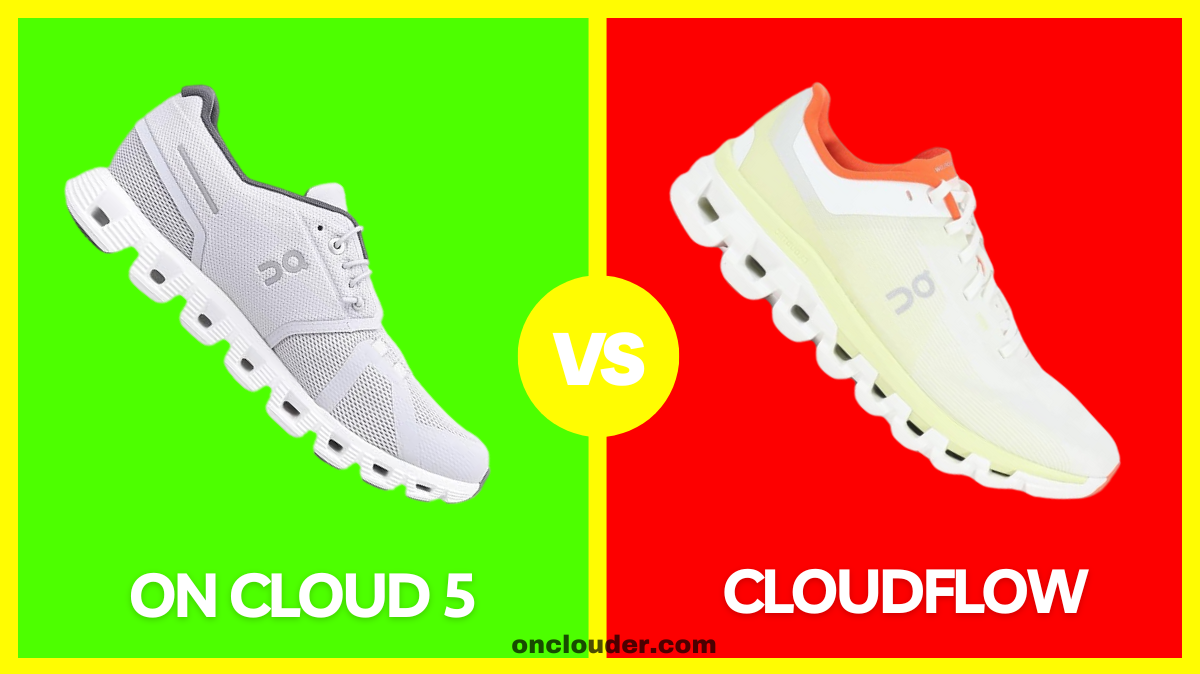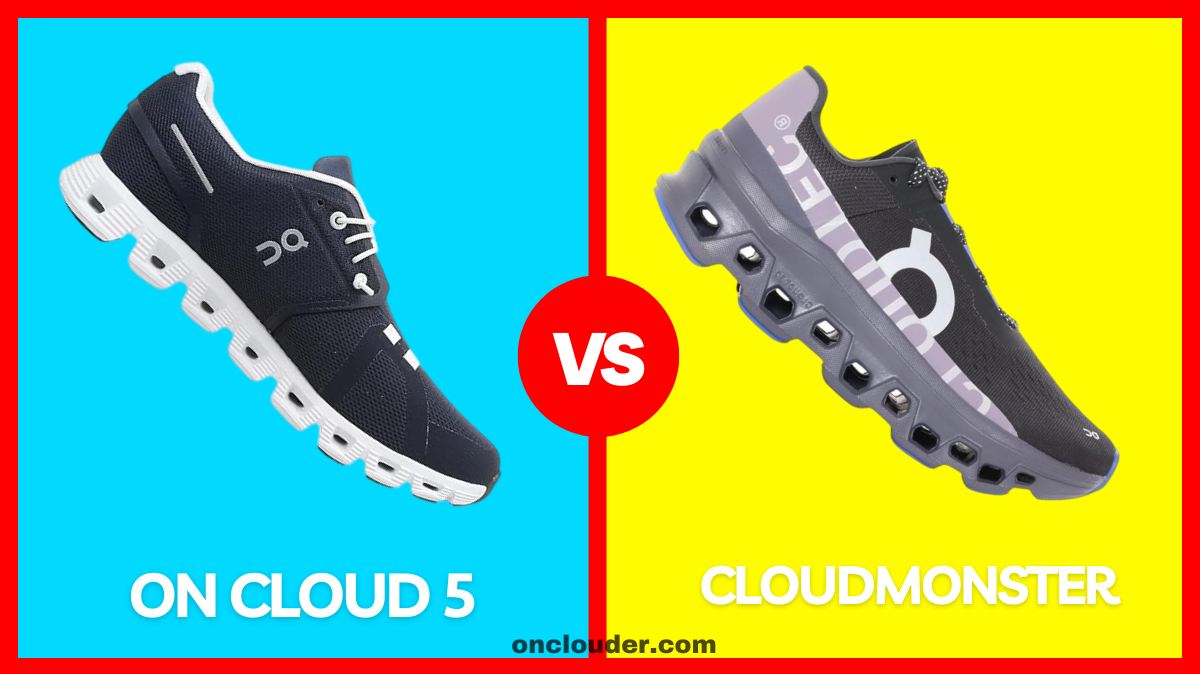Are you in the market for a new pair of running shoes? If so, you’ve likely come across two popular options from the Swiss brand On: the Cloud 5 and the Cloudflow.
Both shoes have garnered attention from runners worldwide, but which one is right for you?
We’ll break down the key features of each shoe to help you make an informed decision.
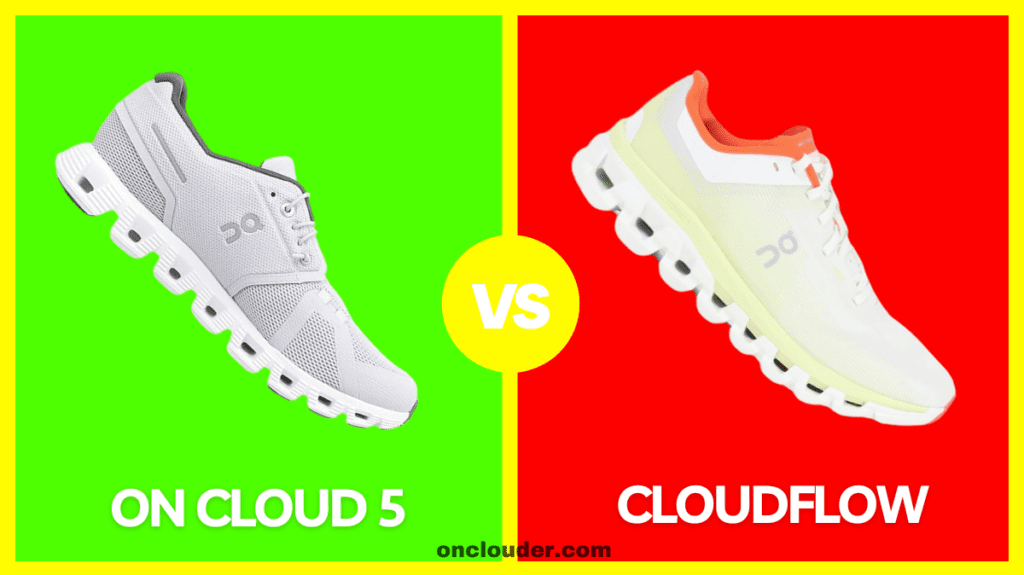
Contents
- 1 On Cloud 5 vs Cloudflow Shoes
- 2 Which Shoes Perfect for Any Activity
- 3 Overview to On Running Shoes
- 4 Durability: Built to Last?
- 5 Breathability: Keeping Your Feet Cool
- 6 Cushioning: Finding the Right Balance
- 7 Shoe Fit: Finding Your Perfect Match
- 8 Stability: Keeping You Steady
- 9 Comfort: The Feel-Good Factor
- 10 Quality: Swiss Engineering at Its Finest
- 11 Style: Looking Good on the Run
- 12 Size: Finding the Right Fit
- 13 Material: The Building Blocks of Performance
- 14 Weight: Light on Your Feet
- 15 Flexibility: Moving with Your Foot
- 16 Water Resistance: Staying Dry on the Run
- 17 Sole: The Foundation of Your Run
- 18 User Reviews: Real Experiences
- 19 Price Comparison
- 20 Pros and Cons
On Cloud 5 vs Cloudflow Shoes
The main difference between On Cloud 5 and Cloudflow shoes lies in their intended use. Cloud 5 is designed for everyday wear and light runs, offering superior comfort and versatility.
In contrast, Cloudflow is geared towards performance running, providing enhanced responsiveness and speed for more serious athletes and longer distances.
Now, let’s create a detailed comparison table for On Cloud 5 vs Cloudflow Shoes:
| Feature | On Cloud 5 | Cloudflow |
| Intended Use | Everyday wear, light runs | Performance running |
| Weight | Lighter (approx. 230g) | Slightly heavier (approx. 235g) |
| Cushioning | Softer, more plush | Firmer, more responsive |
| Heel-to-Toe Drop | 8mm | 6mm |
| Upper Material | Engineered mesh | Helion superfoam |
| Midsole | CloudTec® in Zero-Gravity foam | Helion™ superfoam |
| Outsole | Rubber pods | Rubber grip pads |
| Durability | Moderate | High |
| Breathability | High | Very high |
| Stability | Moderate | High |
| Price Range | $130-$140 | $140-$150 |
| Best For | Casual runners, everyday wear | Serious runners, racing |
| Shoe Profile | Low | Low to medium |
| Flexibility | Very flexible | Moderately flexible |
| Color Options | Wide range | Limited |
Summary: On Cloud 5 and Cloudflow shoes cater to different running needs. The Cloud 5 is designed for everyday wear and casual runs, offering superior comfort and versatility with its softer cushioning and lighter weight. It’s an excellent choice for those who prioritize comfort in their daily activities.
Also Read: Cloud 5 vs Brooks Ghost
Which Shoes Perfect for Any Activity
For Running
On Cloud 5
Designed for lighter, everyday runs. It offers a comfortable, lightweight feel suitable for casual runners and shorter distances. The Cloud 5 provides good energy return but is less performance-oriented than the Cloudflow.
Cloudflow
Better suited for performance-oriented runners. It’s designed for faster-paced runs and races, offering a more responsive feel. The Cloudflow is ideal for runners seeking speed and efficiency in their training and competitions.
For Walking
On Cloud 5
More suitable for walking compared to the Cloudflow. Its lightweight nature and comfortable cushioning make it a good choice for casual walks and everyday wear.
Cloudflow
While it can be used for walking, it’s more running-focused. It may feel overly responsive for casual walking compared to the Cloud 5.
For Standing All Day
On Cloud 5
Better suited for all-day wear in casual or office settings. It offers comfort without a bulky appearance, making it a good choice for those who need to stand for extended periods.
Cloudflow
Less ideal for all-day standing. Its performance-oriented design may not provide the same level of long-term comfort as the Cloud 5 for extended periods of standing.
Overview to On Running Shoes
Before we dive into the specifics of the Cloud 5 and Cloudflow, let’s take a moment to understand what sets On running shoes apart from the competition.
The On Brand Story
On was founded in 2010 by former professional athlete Olivier Bernhard and his friends David Allemann and Caspar Coppetti.
Their goal was to revolutionize the running experience by creating a shoe that provided a soft landing followed by an explosive take-off. This innovative approach led to the development of their signature CloudTec® technology.
CloudTec® Technology: The Heart of On Shoes
At the core of every On running shoe is CloudTec® technology. This unique system features hollow pods on the sole of the shoe, which compress upon impact to cushion your landing and then lock to provide a firm platform for take-off. This technology aims to deliver a running experience that feels “like running on clouds” – hence the brand name.
Now that we’ve covered the basics, let’s compare the Cloud 5 and Cloudflow in detail.
Durability: Built to Last?
When investing in a pair of running shoes, durability is a crucial factor to consider. Let’s see how the Cloud 5 and Cloudflow measure up in this department.
On Cloud 5 Durability
The Cloud 5 is designed with durability in mind, especially for everyday use. Its outsole features:
- Reinforced CloudTec® elements
- Strategically placed rubber pads in high-wear areas
These features help extend the life of the shoe, making it a reliable choice for daily runners and casual wearers alike.
Cloudflow Durability
The Cloudflow, while also durable, is built more for performance than longevity. Its construction includes:
- Helion superfoam in the outsole for increased resilience
- A streamlined design that may wear faster under intense use
While the Cloudflow can certainly handle regular running, it may show signs of wear sooner than the Cloud 5 if used primarily for high-intensity workouts or races.
Also Read: On Cloud 5 vs Cloudflyer
Breathability: Keeping Your Feet Cool
Proper ventilation is essential for comfortable running, especially during warmer months or longer distances. Here’s how these two models compare in terms of breathability:
Cloud 5 Breathability
The Cloud 5 features:
- An engineered mesh upper that promotes airflow
- Strategic perforations to enhance ventilation
These elements work together to keep your feet cool and dry during runs or throughout the day.
Cloudflow Breathability
The Cloudflow takes breathability up a notch with:
- A newly engineered mesh upper designed for maximum airflow
- Ventilated tongue construction
This enhanced breathability makes the Cloudflow an excellent choice for runners who prioritize keeping their feet cool during intense workouts or races.

Cushioning: Finding the Right Balance
Cushioning plays a vital role in your running experience, affecting both comfort and performance. Let’s examine how the Cloud 5 and Cloudflow approach this crucial aspect.
Cloud 5 Cushioning
The Cloud 5 offers:
- Moderate cushioning suitable for everyday use
- Zero-Gravity foam for a soft, comfortable ride
- CloudTec® elements that provide adaptive cushioning
This combination makes the Cloud 5 a versatile choice for various activities, from casual walks to light runs.
Cloudflow Cushioning
The Cloudflow takes a different approach with:
- Helion superfoam for responsive cushioning
- A firmer overall feel compared to the Cloud 5
- CloudTec® elements tuned for performance running
This setup results in a shoe that’s more responsive and better suited for faster-paced runs and races.
Also Read: On Cloud 5 vs Cloudmonster
Shoe Fit: Finding Your Perfect Match
A proper fit is crucial for comfort and performance in any running shoe. Here’s what you need to know about the fit of the Cloud 5 and Cloudflow:
Cloud 5 Fit
The Cloud 5 is designed to accommodate a variety of foot shapes:
- Slightly wider toe box for natural toe splay
- Snug midfoot for secure lockdown
- Available in standard and wide widths
This versatile fit makes the Cloud 5 a great option for those with average to slightly wider feet.
Cloudflow Fit
The Cloudflow offers a more performance-oriented fit:
- Snugger overall fit for a more secure feel
- Narrower toe box compared to the Cloud 5
- Engineered mesh upper that adapts to your foot shape
Runners with narrow to average-width feet may find the Cloudflow more suitable, especially for faster-paced activities.
Stability: Keeping You Steady
Stability is an important factor in preventing injuries and maintaining proper form during your runs. Let’s see how these two models stack up in terms of stability:
Cloud 5 Stability
The Cloud 5 provides moderate stability through:
- A wider base in the heel and forefoot
- Strategically placed CloudTec® elements for balanced support
- A molded heel for secure foot lockdown
These features make the Cloud 5 a good choice for neutral runners or those who need a bit of extra support during everyday activities.
Cloudflow Stability
The Cloudflow offers a different approach to stability:
- A more streamlined design for a closer-to-ground feel
- Helion superfoam for enhanced responsiveness and support
- A snugger fit that helps prevent in-shoe movement
While the Cloudflow may not provide as much inherent stability as the Cloud 5, its design promotes a more natural running gait, which can benefit experienced runners.
Comfort: The Feel-Good Factor
Comfort is subjective, but certain features can contribute to a more enjoyable running experience. Here’s how the Cloud 5 and Cloudflow compare in terms of overall comfort:
Cloud 5 Comfort
The Cloud 5 prioritizes all-day comfort with:
- Soft, plush interior lining
- Adaptive CloudTec® cushioning
- A roomier fit that accommodates foot swelling
These elements make the Cloud 5 an excellent choice for those who value comfort above all else, whether for running or everyday wear.
Cloudflow Comfort
The Cloudflow takes a performance-oriented approach to comfort:
- Engineered mesh upper that adapts to your foot shape
- Responsive Helion superfoam cushioning
- A snugger fit that may feel less plush but more secure
While the Cloudflow may not feel as immediately comfortable as the Cloud 5, many runners find its responsive feel more comfortable during fast-paced runs or races.
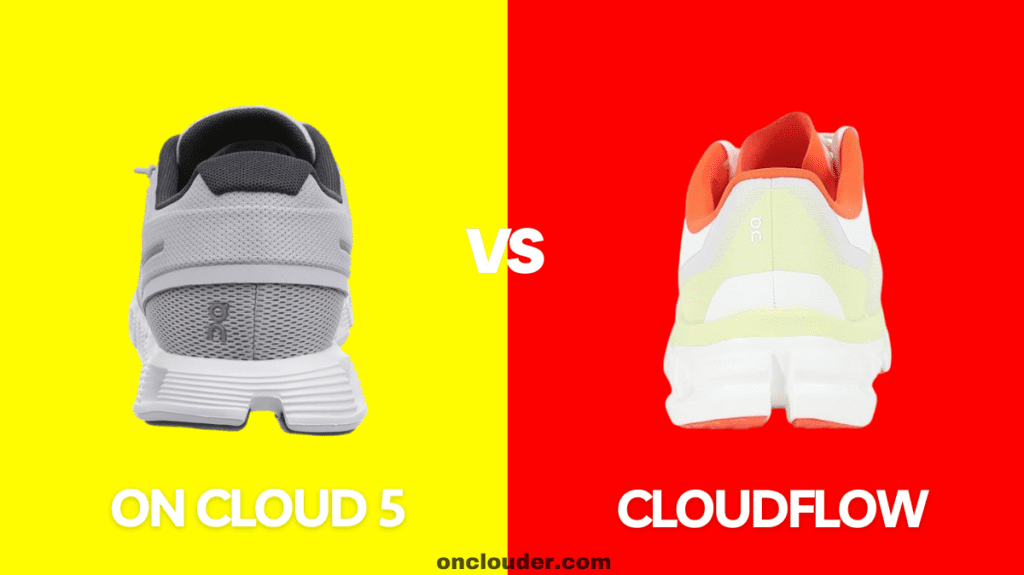
Quality: Swiss Engineering at Its Finest
Both the Cloud 5 and Cloudflow showcase On’s commitment to quality, but there are some differences worth noting:
Cloud 5 Quality
The Cloud 5 demonstrates quality through:
- Durable materials built for everyday use
- Attention to detail in stitching and construction
- Consistent performance across various activities
Cloudflow Quality
The Cloudflow exhibits quality in its:
- High-performance materials like Helion superfoam
- Precision engineering for optimal running efficiency
- Durability that stands up to intense training
Both shoes reflect On’s Swiss engineering heritage, but the Cloudflow’s performance-oriented features may justify its higher price point for serious runners.
Style: Looking Good on the Run
While performance is paramount, style can also play a role in your shoe choice. Let’s compare the aesthetic appeal of the Cloud 5 and Cloudflow:
Cloud 5 Style
The Cloud 5 offers:
- A sleek, minimalist design
- Various color options to suit different tastes
- Versatility for both athletic and casual wear
Its clean lines and understated elegance make the Cloud 5 a popular choice for those who want a shoe that transitions seamlessly from workouts to everyday life.
Cloudflow Style
The Cloudflow presents:
- A more technical, performance-oriented look
- Bold color choices that stand out on the road
- Streamlined silhouette that appeals to serious runners
While the Cloudflow may not be as versatile in terms of casual wear, its eye-catching design is sure to turn heads at your next race or group run.
Size: Finding the Right Fit
Proper sizing is crucial for comfort and performance. Here’s what you need to know about sizing for the Cloud 5 and Cloudflow:
Cloud 5 Sizing
The Cloud 5 generally:
- Runs true to size for most wearers
- Offers a bit more room in the toe box
- Comes in both standard and wide widths
When trying on the Cloud 5, make sure you have about a thumb’s width of space between your longest toe and the end of the shoe.
Cloudflow Sizing
The Cloudflow:
- May run slightly small for some wearers
- Has a snugger overall fit
- Is available in standard width only
Some runners find they need to go up a half size in the Cloudflow, especially if they’re between sizes or prefer a bit more room in the toe box.
Also Read: On Cloud 5 vs Cloudnova
Material: The Building Blocks of Performance
The materials used in a running shoe can significantly impact its performance, durability, and comfort. Let’s examine the materials used in the Cloud 5 and Cloudflow:
Cloud 5 Materials
The Cloud 5 features:
- Engineered mesh upper for breathability and flexibility
- Zero-Gravity foam in the CloudTec® outsole
- Antimicrobial treatment for odor control
These materials contribute to the Cloud 5’s versatility and all-day comfort.
Cloudflow Materials
The Cloudflow utilizes:
- Helion superfoam in the midsole and CloudTec® elements
- Engineered mesh upper designed for high-performance breathability
- Rubber reinforcements in high-wear areas of the outsole
The use of Helion superfoam gives the Cloudflow its responsive feel and enhanced durability.
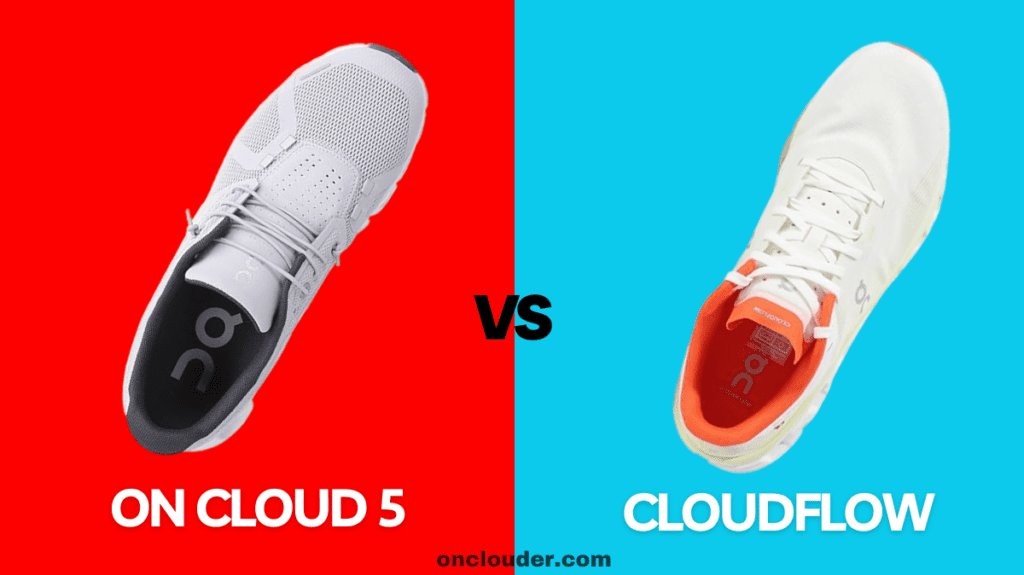
Weight: Light on Your Feet
The weight of a running shoe can affect your speed and endurance. Here’s how the Cloud 5 and Cloudflow compare:
Cloud 5 Weight
- Men’s: Approximately 8.82 oz (250g)
- Women’s: Approximately 7.05 oz (200g)
The Cloud 5’s lightweight design contributes to its versatility and all-day wearability.
Cloudflow Weight
- Men’s: Approximately 9.17 oz (260g)
- Women’s: Approximately 7.76 oz (220g)
While slightly heavier than the Cloud 5, the Cloudflow’s weight is still considered light for a performance running shoe.
Flexibility: Moving with Your Foot
Flexibility in a running shoe allows for a more natural foot movement and can contribute to a more comfortable run. Let’s see how these two models compare:
Cloud 5 Flexibility
The Cloud 5 offers:
- Moderate flexibility throughout the shoe
- CloudTec® elements that allow for natural foot flexion
- A comfortable balance between structure and give
This level of flexibility makes the Cloud 5 suitable for a variety of activities and foot types.
Cloudflow Flexibility
The Cloudflow provides:
- Enhanced flexibility in the forefoot
- A more rigid midfoot for improved energy return
- Speedboard technology for added propulsion
The Cloudflow’s flexibility is optimized for fast-paced running, promoting a quick and efficient toe-off.
Water Resistance: Staying Dry on the Run
While neither shoe is designed to be fully waterproof, some degree of water resistance can be beneficial. Here’s how they compare:
Cloud 5 Water Resistance
The Cloud 5 offers:
- Moderate water resistance in light rain or dew
- Quick-drying engineered mesh upper
- Potential for water to enter through the CloudTec® elements
Cloudflow Water Resistance
The Cloudflow provides:
- Similar water resistance to the Cloud 5 in light moisture
- Engineered mesh that repels some water
- Potential for water entry through the ventilated design
Both shoes are best suited for dry conditions but can handle light moisture. For very wet conditions, On offers other models with enhanced water protection.
Sole: The Foundation of Your Run
The sole of a running shoe plays a crucial role in cushioning, stability, and overall performance. Let’s examine the sole construction of both models:
Cloud 5 Sole
The Cloud 5 sole features:
- CloudTec® elements made from Zero-Gravity foam
- Strategic rubber placements for durability and traction
- A wider base for improved stability
This sole construction provides a balance of cushioning and responsiveness suitable for various activities.
Cloudflow Sole
The Cloudflow sole incorporates:
- CloudTec® elements made from Helion superfoam
- A more streamlined design for faster runs
- Rubber reinforcements in high-wear areas
The Cloudflow’s sole is optimized for performance running, offering a more responsive and efficient ride.
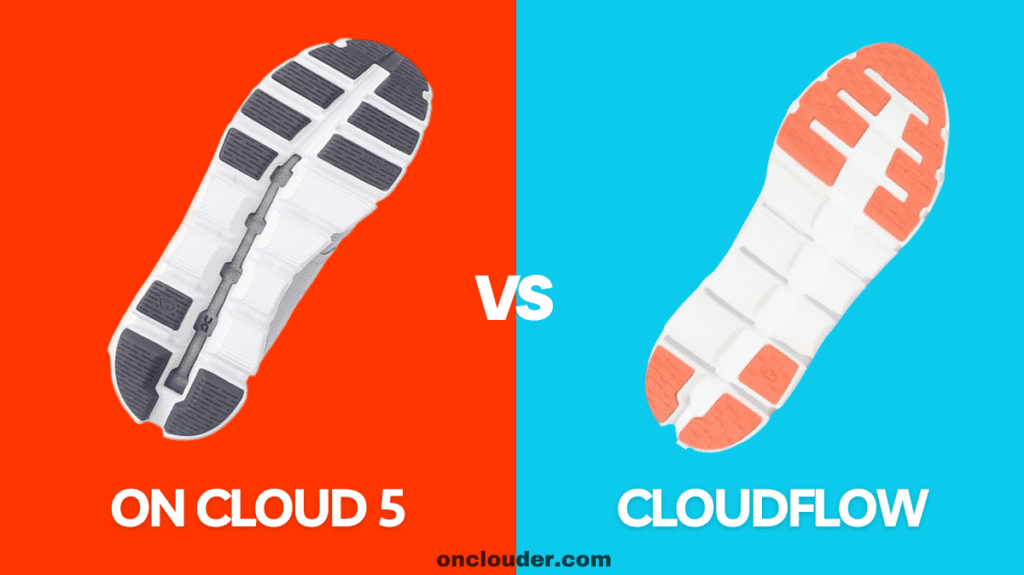
User Reviews: Real Experiences
To give you a better idea of how these shoes perform in the real world, here’s a summary of user reviews for both models:
Cloud 5 User Reviews
| Rating | Percentage of Reviews |
| ⭐⭐⭐⭐⭐ | 70% |
| ⭐⭐⭐⭐⭐ | 20% |
| ⭐⭐⭐⭐⭐ | 7% |
| ⭐⭐⭐⭐⭐ | 2% |
| ⭐⭐⭐⭐⭐ | 1% |
Common praise
- Excellent all-day comfort
- Versatile for various activities
- Stylish design
Common criticisms
- Some users find them less suitable for long-distance running
- Occasional durability issues with heavy use
Cloudflow User Reviews
| Rating | Percentage of Reviews |
| ⭐⭐⭐⭐⭐ | 65% |
| ⭐⭐⭐⭐⭐ | 25% |
| ⭐⭐⭐⭐⭐ | 8% |
| ⭐⭐⭐⭐⭐ | 1% |
| ⭐⭐⭐⭐⭐ | 1% |
Common praise
- Great for fast-paced runs and races
- Responsive and lightweight feel
- Improved breathability
Common criticisms
- Some users find them less comfortable for all-day wear
- Narrower fit may not suit all foot types
Price Comparison
To help you make an informed decision, here’s a price comparison table for the Cloud 5 and Cloudflow:
| Model | MSRP | Typical Sale Price |
| On Cloud 5 | $129.99 | $99.99 – $119.99 |
| On Cloudflow | $139.99 | $109.99 – $129.99 |
Please note that prices may vary depending on the retailer and any ongoing promotions.
Also Read: On Cloud 5 vs Cloudstratus
Pros and Cons
Pros: On Cloud 5
- Versatile for everyday wear and light runs
- Lightweight and comfortable
- Suitable for walking and standing all day
- Stylish design for casual settings
- More color options available
Cons: On Cloud 5
- Less suitable for intense running sessions
- May lack performance features for serious runners
- Less responsive than Cloudflow for speed work
- Not ideal for long-distance running
Pros: Cloudflow
- Designed for performance running
- Highly responsive for speed work and races
- Better for longer distances and intense training
- Provides good energy return
- Offers more stability for serious runners
Cons: Cloudflow
- Less comfortable for all-day wear
- Not as versatile for casual use
- May feel too responsive for walking
- Typically more expensive
- Fewer color options compared to Cloud 5
In conclusion: After this comprehensive comparison, it’s clear that both the On Cloud 5 and the Cloudflow have their strengths. Your choice between the two will depend on your specific needs and preferences.
Choose the Cloud 5 if
- You want a versatile shoe for both running and everyday wear
- Comfort is your top priority
- You prefer a softer, more cushioned ride
- You have wider feet or need a roomier toe box
Opt for the Cloudflow if
- You’re a performance-oriented runner looking for speed
- You prefer a more responsive, firmer feel
- You have narrow to average-width feet
- You’re willing to invest a bit more for enhanced running technology
Are On shoes suitable for overpronation or underpronation?
Yes, On shoes are designed to provide excellent stability and support for various foot types, including overpronation and underpronation.
How long do On shoes typically last?
The lifespan of On shoes can vary depending on factors such as the individual’s running style, mileage, and the terrain they train on.
Can On shoes be used for activities other than running?
Absolutely! While On shoes are primarily designed for running, their versatile and comfortable construction makes them suitable for various activities.
Many users enjoy wearing their On shoes for gym workouts, cross-training sessions, or even casual everyday wear.
How do I choose the right size for On shoes?
Choosing the right size is crucial for a comfortable and performance-driven fit. On recommends trying on their shoes in the afternoon or evening when your feet are at their largest due to natural swelling.
Are On shoes environmentally friendly?
On is committed to sustainability and has taken steps to reduce its environmental footprint. Many of their shoe models, including the Cloud 5 and Cloudflow, feature partially recycled materials in their construction.

